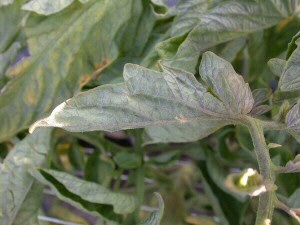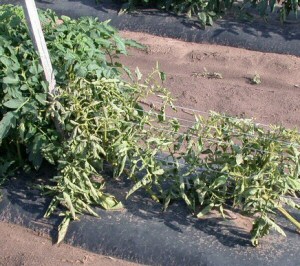Curly Top Disease of Tomato
 Causal Agent
Causal Agent
Beet Curly Top Virus (BCTV)
Hosts
Tomatoes, beans, pepper, spinach, beets, and cucurbits.
Symptoms

BCTV is transmitted to from plant to plant by the beet leafhopper, Circulifer tenellus. Both the virus and the beet leafhopper have very wide host ranges. Once acquired by the leafhopper, BCTV is carried for the rest of the leafhopper's life, and thus long distance spread is common. Infected plants are usually scattered in a field. The beet leafhopper acquires the virus from infected crop plants or weeds such as wild mustards and Russian thistle. Only brief feeding periods (minutes) are required for the leafhopper to acquire the virus and transmit it to new plants. Plants begin to show symptoms about 7 to 14 days after they are first infected by a leafhopper. Tomato is not a preferred host for the beet leafhopper; however the leafhoppers transmit the virus to tomato while sampling it.
Affected plants do not recover and die or remain stunted without setting additional fruit. For some time now, the problem has been attributed to feeding by the potato (or tomato) psyllid which causes psyllid yellows. In psyllid yellows, damage is caused by a toxin that the immature psyllids (nymphs) produce as they feed. Reported symptoms of psyllid yellows are very similar to those observed on the affected tomato plants.
Control
Management of curly top disease is difficult. Efforts to breed resistance to curly top into tomatoes have been largely unsuccessful. All currently available tomato varieties are susceptible. Spraying tomatoes with insecticides does not control the disease because leafhoppers migrate from distant places and do not reproduce or remain in tomato fields. By the time migrating leafhoppers succumb to an insecticide, they have already transmitted the virus to the tomatoes. When symptoms of curly top become evident in tomatoes, the leafhoppers have long since moved away to other crops or weeds which they prefer. Removing symptomatic plants is probably a good idea, but since the vector does not remain in tomato fields, there probably is little secondary, or plant to plant spread within a field. Other management strategies have focused on using cultural practices that reduce the attractiveness of tomato to the leafhoppers. The beet leafhopper (and most other insect vectors) is attracted to widely spaced, vigorous plants grown in open areas where the plants sharply contrast with the surrounding soil. In areas where curly top is chronic, dense plant spacing, shading, row covers, and intercropping have been reported to reduce levels of curly top.

